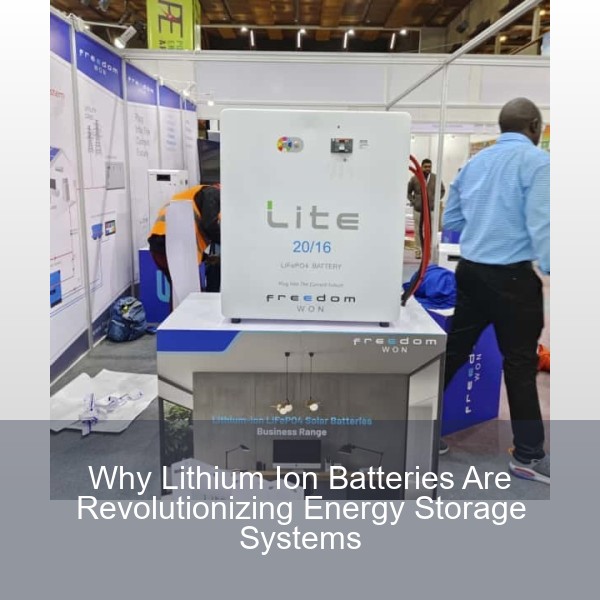Why Lithium Ion Batteries Are Revolutionizing Energy Storage Systems

The Power Punch Behind Modern Energy Storage
Ever wondered what keeps your smartphone alive through endless cat videos and work emails? Meet the unsung hero: lithium ion batteries. But here's the kicker – these energy powerhouses aren't just for gadgets anymore. From solar farms to hospital backup systems, lithium ion batteries for energy storage systems are rewriting the rules of energy management. Let's unpack why engineers are choosing these batteries over traditional lead-acid options faster than you can say "electrochemical potential".
Energy Density: The Space-Saving Superpower
Imagine trying to store an elephant in a studio apartment. That's essentially the challenge with energy storage. Lithium ion batteries solve this with:
- 3-4x higher energy density than lead-acid batteries
- 50% reduction in physical footprint for equivalent storage capacity
- Modular design allowing vertical stacking (great for urban installations)
The Hornsdale Power Reserve in Australia – the world's largest lithium-ion battery installation – stores 150MW in an area smaller than three football fields. Try that with lead-acid!
Case Study: Solar Farm Transformation
When the Mount Signal Solar Farm in California switched to lithium-ion storage, they boosted energy retention by 40% while reducing maintenance costs. Their facility manager joked: "Our batteries now need less babysitting than my teenage nephew."
Longevity That Outlasts Your Phone Upgrade Cycle
While your smartphone battery starts wheezing after two years, lithium ion batteries for energy storage systems are marathon runners:
- 5,000+ deep discharge cycles (lead-acid manages 500-1,000)
- 20-year lifespan with proper battery management systems (BMS)
- Only 2-3% annual capacity loss versus 5-10% in alternatives
German manufacturer Sonnen reports their residential storage systems still deliver 80% capacity after 10,000 cycles. That's like charging your phone daily for 27 years!
Cost Efficiency: The Numbers Don't Lie
Let's talk dollars and sense. While upfront costs might make your accountant blink, the long-term math sings a different tune:
| Cost Factor | Lithium-Ion | Lead-Acid |
|---|---|---|
| Installation Cost/kWh | $400-$750 | $200-$400 |
| Lifetime Cost/kWh | $0.10-$0.20 | $0.30-$0.50 |
The US Department of Energy reports lithium-ion systems achieve 95% round-trip efficiency versus 80-85% for alternatives. That missing 15%? Enough to power 15 refrigerators for a year in a medium-sized storage setup.
Environmental Edge: Greener Than a Tesla in a Forest
Contrary to popular belief, today's lithium ion batteries aren't environmental villains. Modern advancements include:
- 90% recyclability rates in new battery designs
- Cobalt-free chemistries (LFPs gaining market share)
- Closed-loop manufacturing processes
California's recent CEC regulations now mandate 100% recyclable battery components by 2025 – and guess which technology is leading compliance?
When Safety Meets Innovation
Remember the Samsung Note 7 fiasco? Modern ESS-grade lithium batteries have more safety features than a nuclear reactor:
- Thermal runaway prevention systems
- AI-powered anomaly detection
- Fire-retardant ceramic separators
A recent UL Solutions study showed lithium-ion storage systems have 0.0042% failure rates – safer than traditional generators.
Real-World Applications: Beyond Theory
From the Swiss Alps to the Australian Outback, lithium-ion ESS are making waves:
- Tesla's Powerpack project in Puerto Rico surviving 5 hurricanes
- South Australia's Virtual Power Plant linking 50,000 solar homes
- Hospital chains achieving 99.9999% power reliability
An amusing anecdote: When a Texas data center switched to lithium backup, their IT team complained the "too reliable" system made their disaster drills less dramatic!
The Future: Where Battery Tech Meets Sci-Fi
Emerging trends are pushing boundaries even further:
- Solid-state batteries entering commercial production (QuantumScape's 2025 roadmap)
- Graphene-enhanced anodes boosting charge rates by 3x
- Self-healing electrolytes extending lifespan beyond 30 years
As industry veteran Dr. Maria Chavez from MIT Energy Initiative notes: "We're not just improving batteries – we're redefining what energy storage means." The next decade might see lithium-ion ESS becoming as ubiquitous as power lines – but far more interesting to watch evolve.
- Pre: Portable Energy Storage Systems: Powering the Future of On-the-Go Lifestyles
- Next: How the Inflation Reduction Act Supercharges Energy Storage Innovation
Related Contents

Commercial Lithium Energy Storage Systems: Powering Business Efficiency in the Energy Revolution
A California winery slashes its energy bills by 40% simply by storing cheap solar power during daylight hours. That's the reality commercial lithium energy storage systems bring to the table. As electricity prices play hopscotch with corporate budgets, these systems have become the Swiss Army knives of energy management - cutting costs, boosting sustainability, and keeping operations humming.

Why Lithium Ion Batteries Are Revolutionizing Energy Storage Systems
Ever wondered what keeps your smartphone alive through endless cat videos and work emails? Meet the unsung hero: lithium ion batteries. But here's the kicker – these energy powerhouses aren't just for gadgets anymore. From solar farms to hospital backup systems, lithium ion batteries for energy storage systems are rewriting the rules of energy management. Let's unpack why engineers are choosing these batteries over traditional lead-acid options faster than you can say "electrochemical potential".

Why Lithium Batteries Are Powering the Future of Energy Storage Systems
If you've ever wondered how renewable energy projects keep the lights on when the sun isn't shining or wind isn't blowing, let me introduce you to the rockstar of modern power solutions - the energy storage system lithium battery. These technological marvels are doing for electricity what refrigerators did for food preservation, and they're reshaping our energy landscape in ways that would make Nikola Tesla grin.
